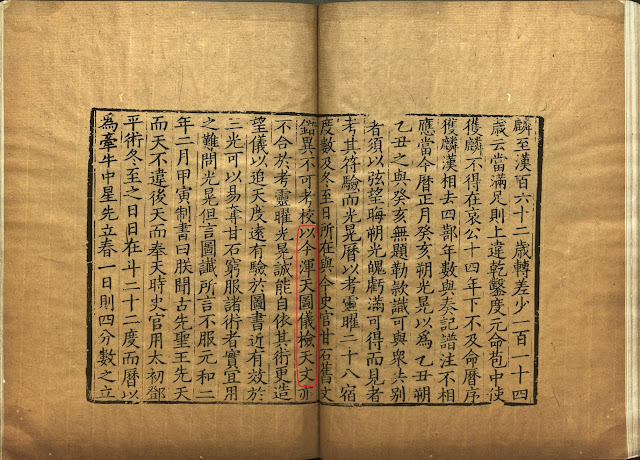全儀 (渾儀),
古人很多時把渾儀 (觀測用 for observation, 望淮)跟 渾象(演示用for demonstration, 象天) 混為一談
浑仪的改进和完善,经历了一个由简而繁,而又由繁而简的历程。
石氏星經 (石申,甘德) : 單環渾儀(跟據李約瑟研究)In any case the definition of the star-positions in degrees presupposes a clear conception of the great circles of the celestial sphere, and an apparatus capable of measuring along with some accuracy. In the fourth century B.C. this may have been only a single armillary ring held steady in different directions of space...
从汉代到北宋,浑仪的环数不断增加。
首先增加的是黄道环,用以观测太阳的位置。
接着又增加了地平环和子午环,地平环固定在地平方向,子午环固定在天体的极轴方向。这样,浑仪便形成了二重结构。
唐代起,浑仪又发展成三重结构。最外面的一层叫六合仪,由固定在一起的地平环、子午环和外赤道环组成,因东西、南北、上下6個方向叫六合,故名。
第二重叫三辰仪,由黄道环、白道环和内赤道环组成,可以绕极轴旋转。其中白道环用以观测月亮的位置。最里层是四游仪。
北宋时,又增加有二分环和二至环,即过二分(春分、秋分)点和二至(夏至、冬至)点的赤经环。
這樣複雜的設計大大降低其實用性,生產製做的困難。在大溫差環境時,有機會做成內環不能轉動,或外環軸心需要有大的虛位,tolerance,因而降低其精準度。
估計 刻度 15 arc minute (0.25 degrees)
似乎實質用來作為複離的二分二至“報時鐘”,或節氣“報時鐘”,多於用作科學觀測。
Single purpose vs multi purpose:
Accuracy
Size weight and portability
環本身遮擋天區的觀測,esp 天球北極區附近。
劉昭 後漢書 注補 , ctext, ctext2 2 (渾儀? 渾象?)
p50:
Ptolemy himself provides instructions on how to build this model of the cosmos in Chapter 1, Book 5 of his opus magnum, Almagest.
three observatories in the Islamic world which used the armillary sphere. In the 13th century, the Maragha Observatory (modern-day Iran) used an armillary sphere. In the 15th century, the Samarkand Observatory (modern-day Uzbekistan) used an armillary sphere. In the 16th century, the Istanbul Observatory (modern-day Turkey) used an armillary sphere.
In the 16th century, well-known European astronomer Tycho Brahe constructed and used several armillary spheres. He built them of steel, brass, and wood held together by screws, in order to avoid warping materials which would render the instrument inaccurate. His armillary spheres were quite large, over 1.5 meters in diameter, and very accurate in their readings. Our good friend Copernicus also constructed armillary spheres in this time period, and gave rise to ideas which would lead to a different take on the instrument altogether.
Armillary of Copernicus (L) and Ptolemy (R)
cons:
limitation of physical size. the largest made is 2 to 4 metres in diameter. 17 tons. not really suitable for transport to other sites for observation.
double ring can block the observations
position of stars and planets are measured by naked eye. the accuracy is limited to 1 decimal digit of a degree, or more.
pre Copernicus era, the model is based on earth centric(geocentric), and thus need to conversion needed for alt az notation and zodiac notation
黃道游儀 3D打印模型 kknews 舊唐書長安十二時辰 44集 13:54
簡儀
多重环结构的浑仪虽是一杰出的创造,在天文学史上也起过重要的作用,但其自身也存在着两大缺陷。一是要把这么多的圆环组装得中心都相重合,十分困难,因而易产生中心差coaxiality problem,造成观测的偏差。一是每个环都会遮蔽一定的天区,环数越多,遮蔽的天区也越大,这就妨碍观测,降低使用效率。
另一改良是減低對赤極軸心的負荷,減少因軸心的變形(flex)而產生的誤差。
支撑简仪创制理论的弧三角法,正是从伊斯兰天文学家那里习得的。有了弧三角法,郭守敬才得以化繁为简,成功创制出简仪。孤矢割圓術
使用弧三角法,可以直接脱开那些繁杂的仪器,间接通过三角学计算求得。否则,不仅黄道部件无法去掉,日晷三器也是没法合并。
kknews文章有誤解:
Torquetum 能在地平<>黃道<>赤道轉換坐標,簡儀則不能。
李氏是指freed from the prison of great circles, dissection of armillary sphere into its component circles,即捨棄“環中有環”的設計
碰撞出火花?還是抄襲模仿?
郭守敬的简仪与扎马鲁丁的平纬仪之间有着某种密切的联系。薄树人先生指出:“郭守敬的简仪的百刻环(用來確定時刻)上把一刻(1/4時辰)分成三十六等分 ,就是阿拉伯天文学中360度分划制的反映。”(注:《中国大百科全书·天文卷》第547页,中国大百科全书出版社1988年版。)ie 1 2/3 arc minute
CCTV YouTube ,bilibili 中有介紹也誤導(7:56~8:07祗是百刻環改為36分)。界衡的針頭太寬圓,容易有視差 parallax。觀際上會有1~2小刻度的讀誤差。
明朝《大统通占》星表数据精确到10古分(0.1古度), 故宋渾仪不大可能是明初观测所用仪器.很可能是元代製做。
古觀象台的簡儀:

現代大型天文望遠鏡都放棄使用赤道式,而改用水平式Alt Az
簡儀的赤經環最小刻度為0.1古度, 理論誤差 0.2 古度 , 即 360/365.25 * 0.2 = 11.8' (arcmin)
Tycho Brahe 的 quadrant accuracy ~ +/- 25" (arcsec)
減少誤差其中一方法是多次,多年的觀測, 去取平均值及標準差standard deviation, 去除systematic error
Pursuit to measure sub-division angles
Scale for enhanced precision :
Tycho Brahe 的 Transverse scale 沒有出現在渾儀或簡儀上, 可以推論背後的 geometry/similar triangle,及做graduation技術仍沒有掌扼。
問題:
類似 Jacob staff (cross staff) 的 stick instrument是何時開始應用?牽星板?
沒有出現transverse scale, 到底郭守敬的渾儀,簡儀有沒領先Tycho Brahe 三,四百年?
Reference:
nmns edu tw 簡儀
欽定古今圖象集成磯衡撫辰儀kknews
















留言
張貼留言